Second Acts: The art of Warren King
Warren King is new to the title “artist.” So new in fact he’s not sure he’s comfortable with it yet. He’s still trying to hash out what it means, exactly. But anyone who was lucky enough to catch his cardboard man (see more on that below) in Tribeca Park last week would have a hard time arguing otherwise.
King (51) grew up in Wisconsin, destined from birth (his words) to take over his father’s structural engineering company after college. And he did, for a time. But with the internet boom came a job with a company that did data mining and analysis, and eventually a job as a tech consultant — “as far from art as you can possibly imagine.”
He and his wife, Rochelle King, raised their family largely in the Bay Area, moving on a whim to Stockholm for four years before landing in Tribeca a couple years ago.
He had an interest in art growing up — “I drew all the time” — but he looked at it as a hobby and never practiced it seriously, taking just a handful of classes in drawing and painting in college. Then, when his own boys were young, he would make them costumes and Halloween masks out of cardboard. He realized he had a knack, and more over, his kids’ schools realized he had a knack too. “So I began doing all their theater productions — I did monkeys, all kinds of birds, gorillas, horses, five or six full sets of armor in the Chinese style, knights, airplanes.”
But during the family’s time in Stockholm, his son issued a challenge. “He said I should make something for myself — and that had never occurred to me,” King said. “I started thinking about it and decided to make a figure and one thing led to another. I thought, who should I make? what’s my inspiration for this?” At the time he was thinking a lot about family histories, having visited China for the first time, and it started to click.
“I had a really profound experience in China. People remembered my family — people we met in their town — and the memory of those people we ran into in the streets was so valuable. So I made a few figures based on photographs and personally it was very rewarding. The process of making them gave me a connection to them that I didn’t have before.”
He stumbled on a little artist collective in Stockholm, and one of the perks was to put on a show of your work once a year. By then he had five or six figures, and some folks with a gallery in town saw them and offered him a show. One thing led to another and soon, it seems, he couldn’t see himself going back to software — making art was way more fun.
“It’s just been happenstance and luck,” King said. “I had never thought of myself as an artist at all — in fact it’s been a difficult process to even learn what that really means. My work before was all very data oriented and math oriented. There’s a project and you do it and you can measure success by the specs. Coming into art where you are looking at creativity and expression and have people react to it — that was really foreign to me.”
So, enter the figure in Tribeca Park.
King wanted to try leaving one of his figures in a public space, but since they usually take two to three weeks to construct, he sped up his process and cranked one out in three days to make it less painful if it “walked away.” He put his villager out in the morning, on a bench facing uptown. Then he sat around for a while. Watched. Left. Came back around 9:30.
That’s when I showed up on a Citi Bike, after my friend Julie had sent me a photo via text. Two men who were speaking Spanish were sitting across from the sculpture, and one of them found a QR code hidden in the back. We both took pictures, figured out it was a link to Instagram. The three of us shared a moment — all kind of in awe — chatted a bit with hand gestures while I took my pictures, and then I left.
Meanwhile King was nearby, watching the two men watch his figure for a long while. Folks came by, snapped a photo, maybe took a selfie and then walked on. Those two men were among the few that stopped and really looked at it.
“It’s maybe just a statement about our culture these days. But those two guys were really taking it in. They spent a good 30 or 40 minutes there and had a big discussion about it and seemed really moved by it. At some point I decided to tell them to take it, but I didn’t act on it.”
Then they left. But before they did, he noticed he had a new follower on Instagram — someone who was following only one person: him.
“When I had this idea to put one out in public, my wife said, ‘what if someone takes it?’ I realized the worst thing would be if someone vandalized it, but if someone took it because they loved it, I was ok with that.”
Finally King left too, headed uptown. He saw the villager sitting there around 6 or so, and by 7 it was gone. He posted about its departure on Instagram. “I had mixed feelings because you don’t really know what happened to it.” A few minutes later he got a response to his post. “I liked your work of art, I couldn’t leave it in the park.” And with it a picture of the figure in someone’s home. The working theory: that the guys saw it in the morning and waited till the end of the day to see if it was still there.
King was thrilled.
“It really made me think about what I am doing this with this whole thing. Of course you want to sell or whatever but at the end of the day you really want to connect with people. If it goes to a collector, it is not there for others to enjoy either. The accepted outcome for art is for it to go to someone’s living room and I prefer this.”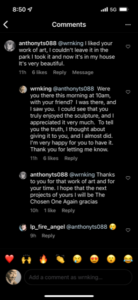
King has loved living in such close proximity to Chinatown — an unexpected perk of settling in Tribeca. (“We knew the benefits of living in this area, but being new to New York we didn’t know the depth of it and then we said oh wow, we are so lucky to have landed here.”) And a result of his time spent there is a new relationship with Pearl River Mart. He pitched them an idea for their gallery space at the new store, likely coming in February.
Till then, keep watching the streets for the next cardboard man. “That day was just a roller coaster. In 12 hours so much transpired and it was all very gratifying. I’ll definitely do it again. There’s no better outcome that could have come from this.”







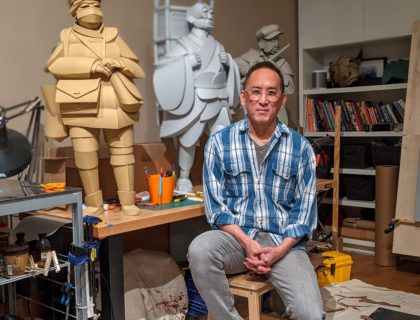
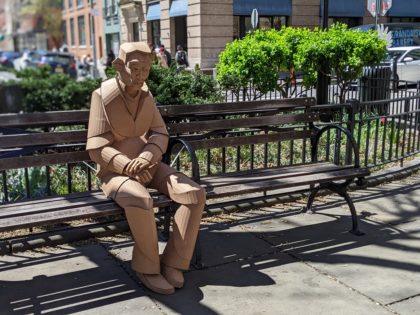
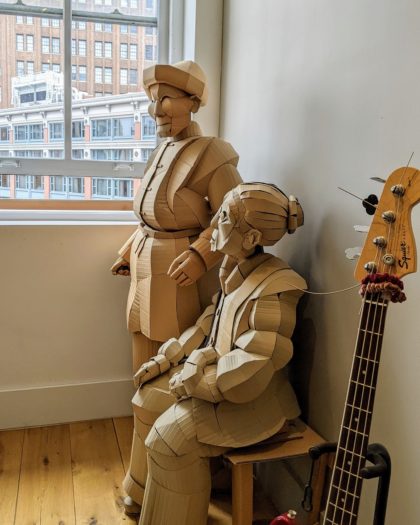
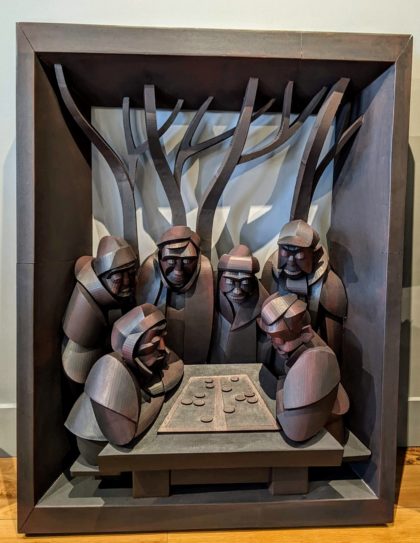
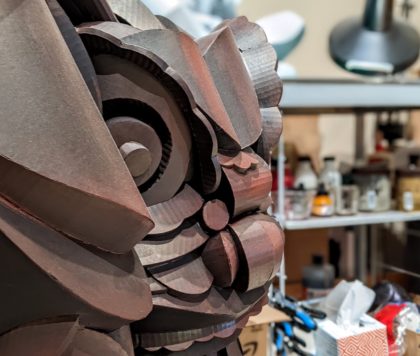
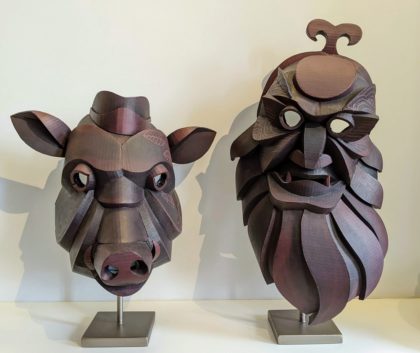








What a way to start the day! Wonderful story, beautiful art.
Ditto
Yes, very much so. An artist you are Mr. King. Just lovely and so much feeling.
I found Warren King’s story – and the story of that experimental public art day – very moving. What a wonderful neighborhood find! Thank you.